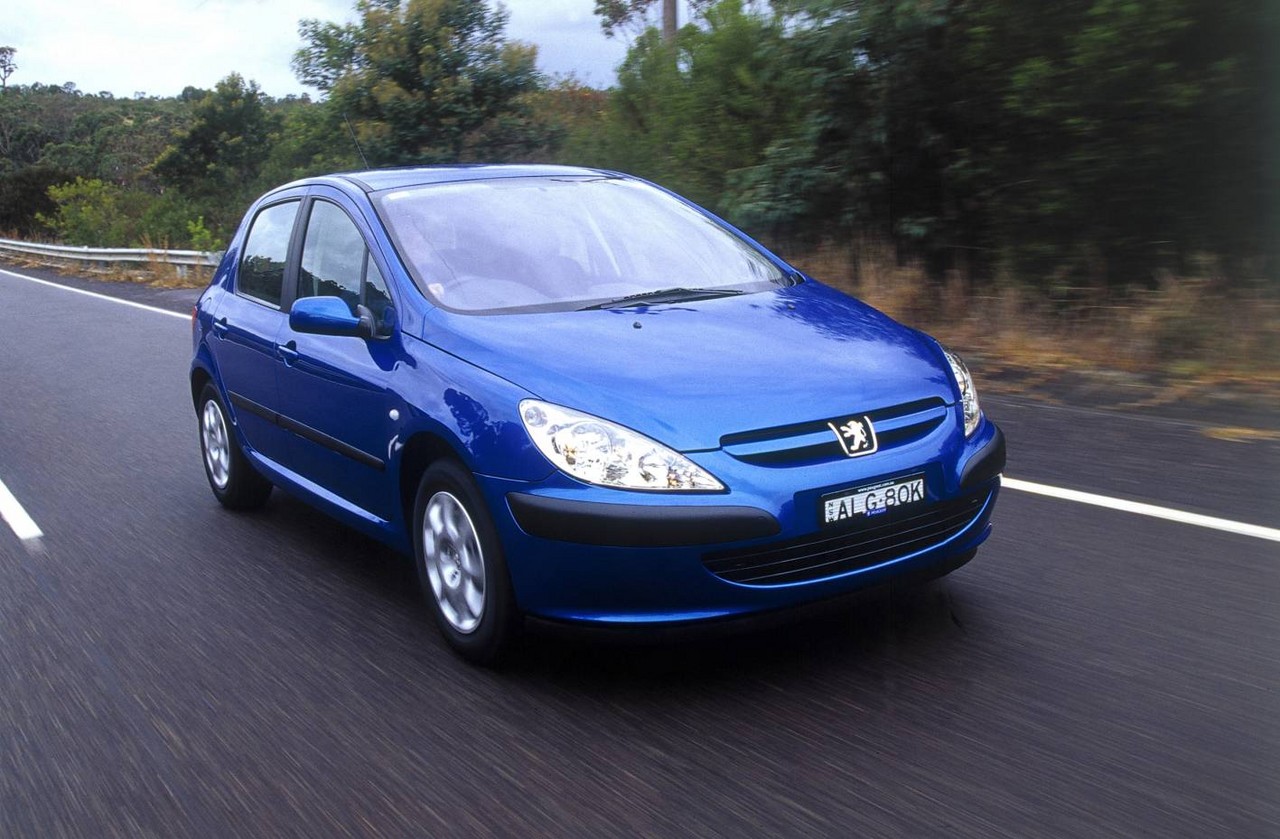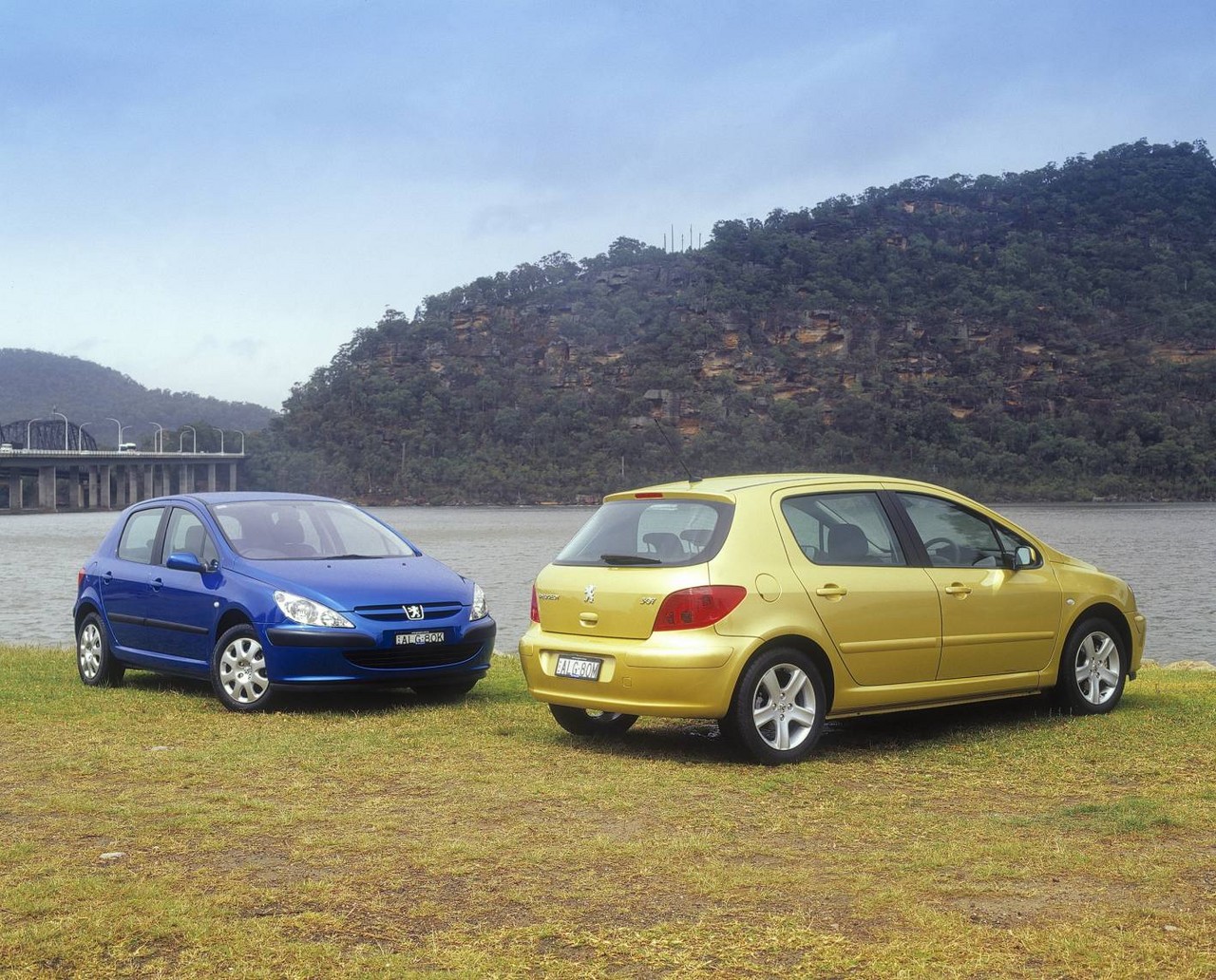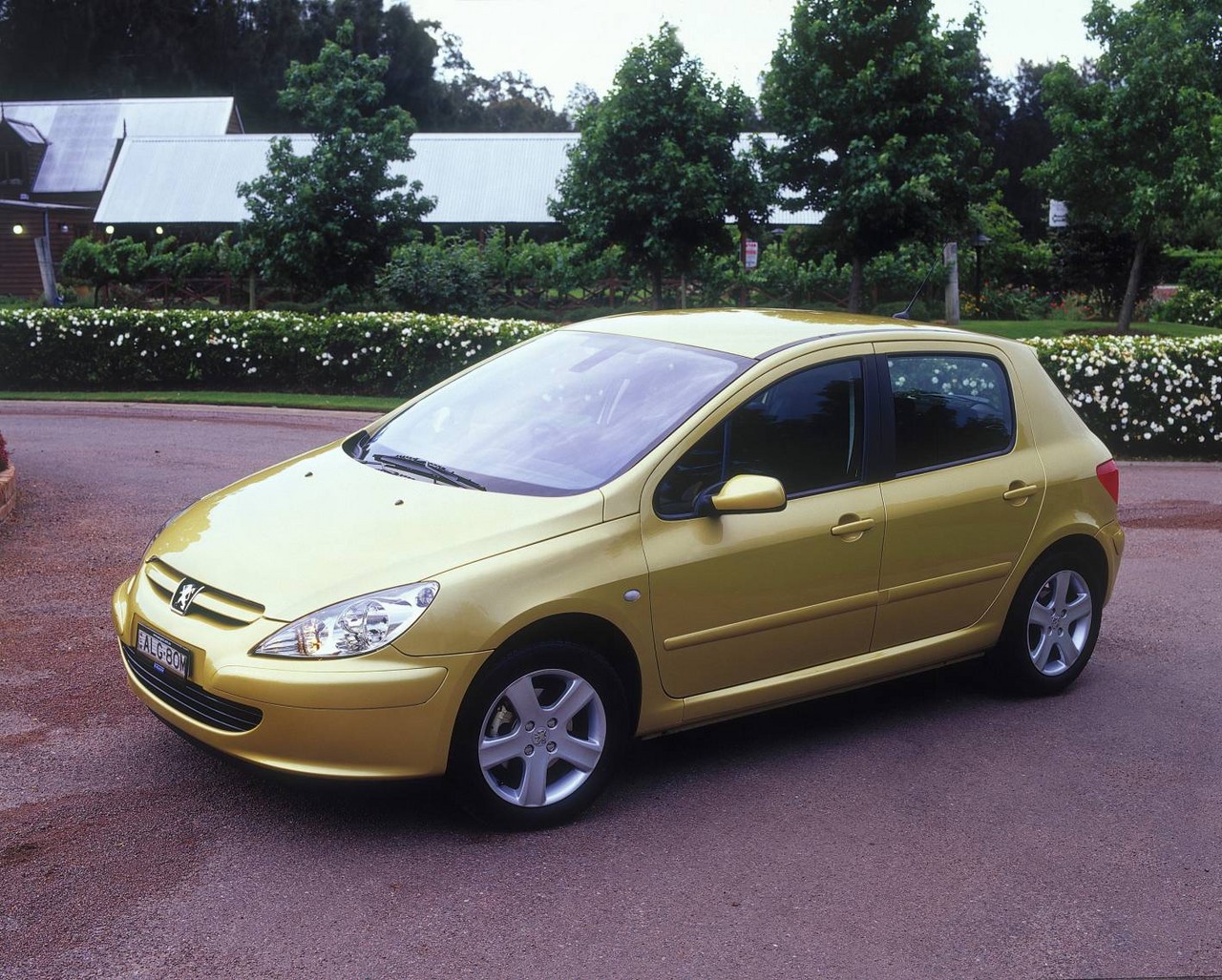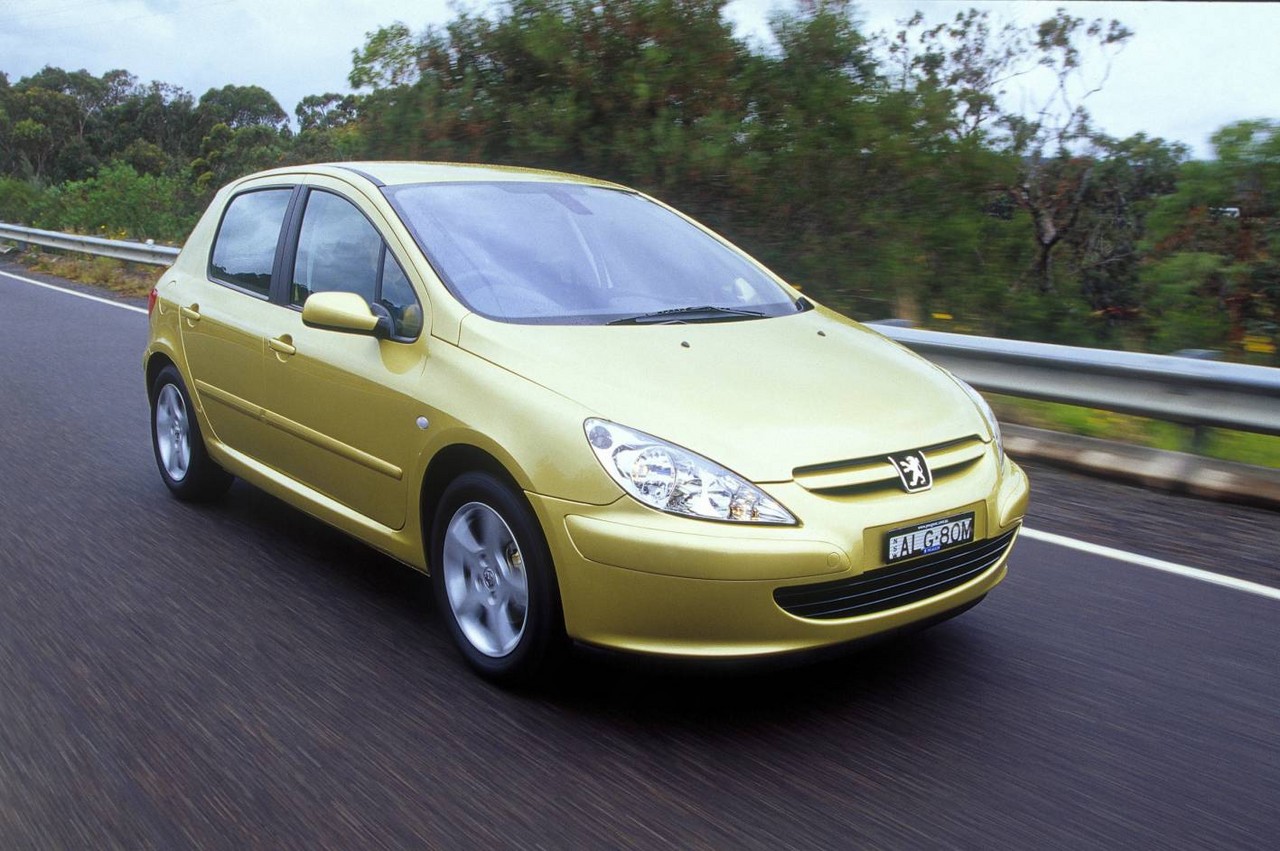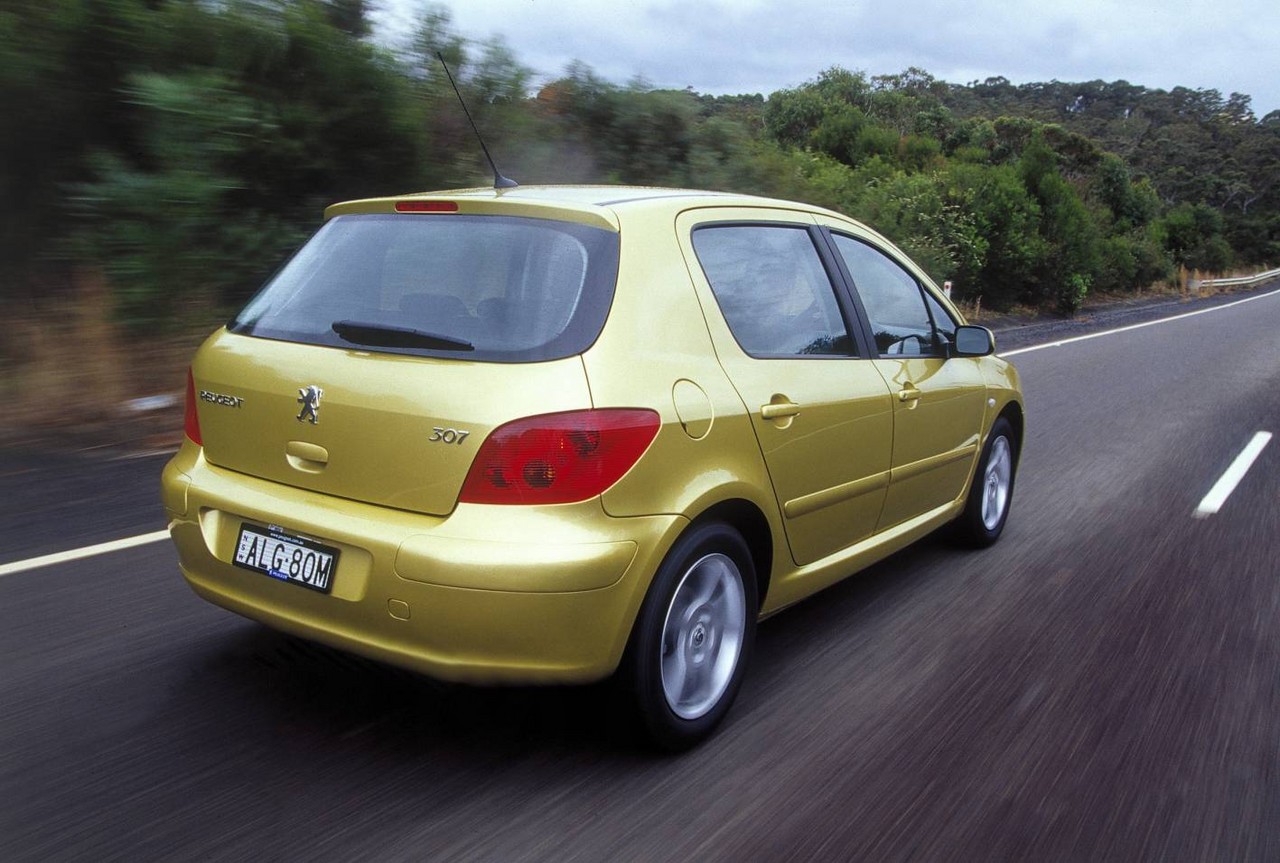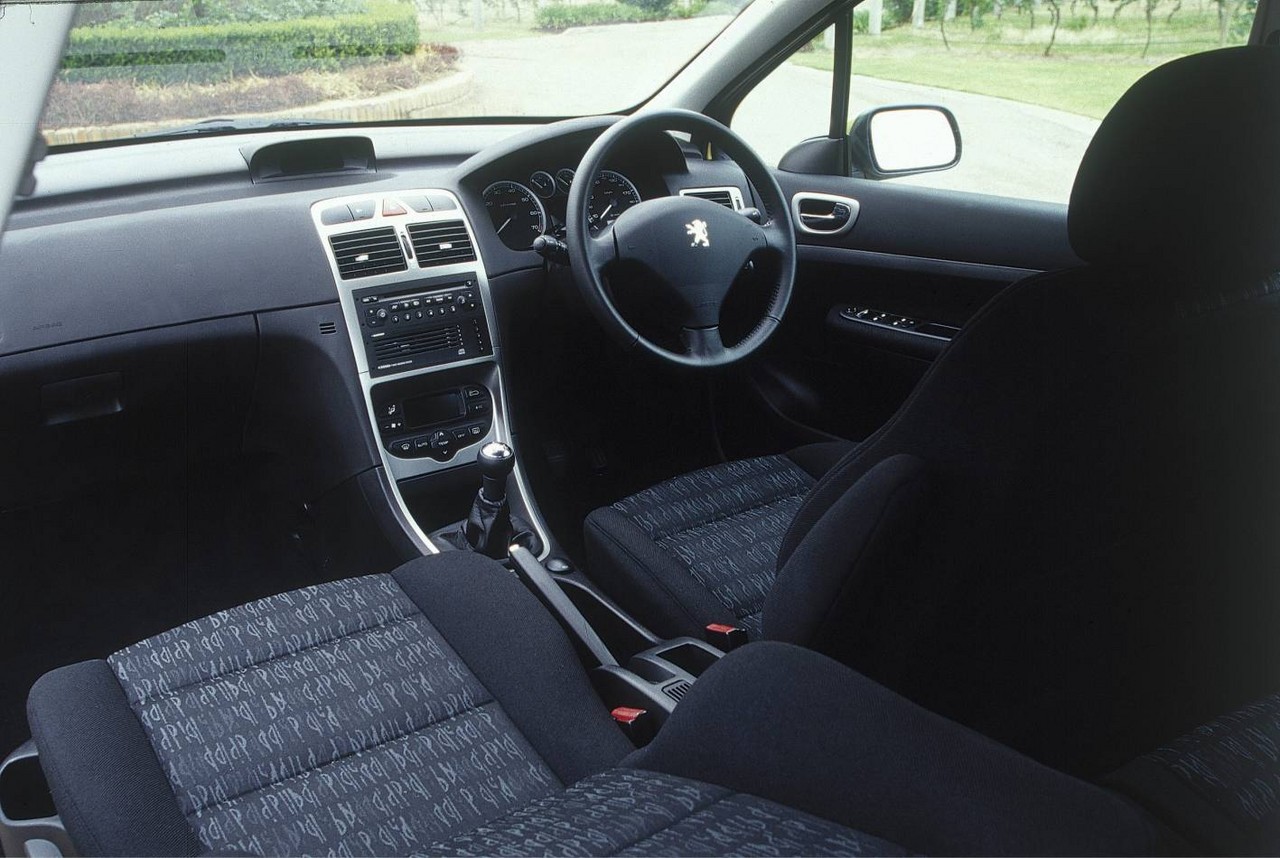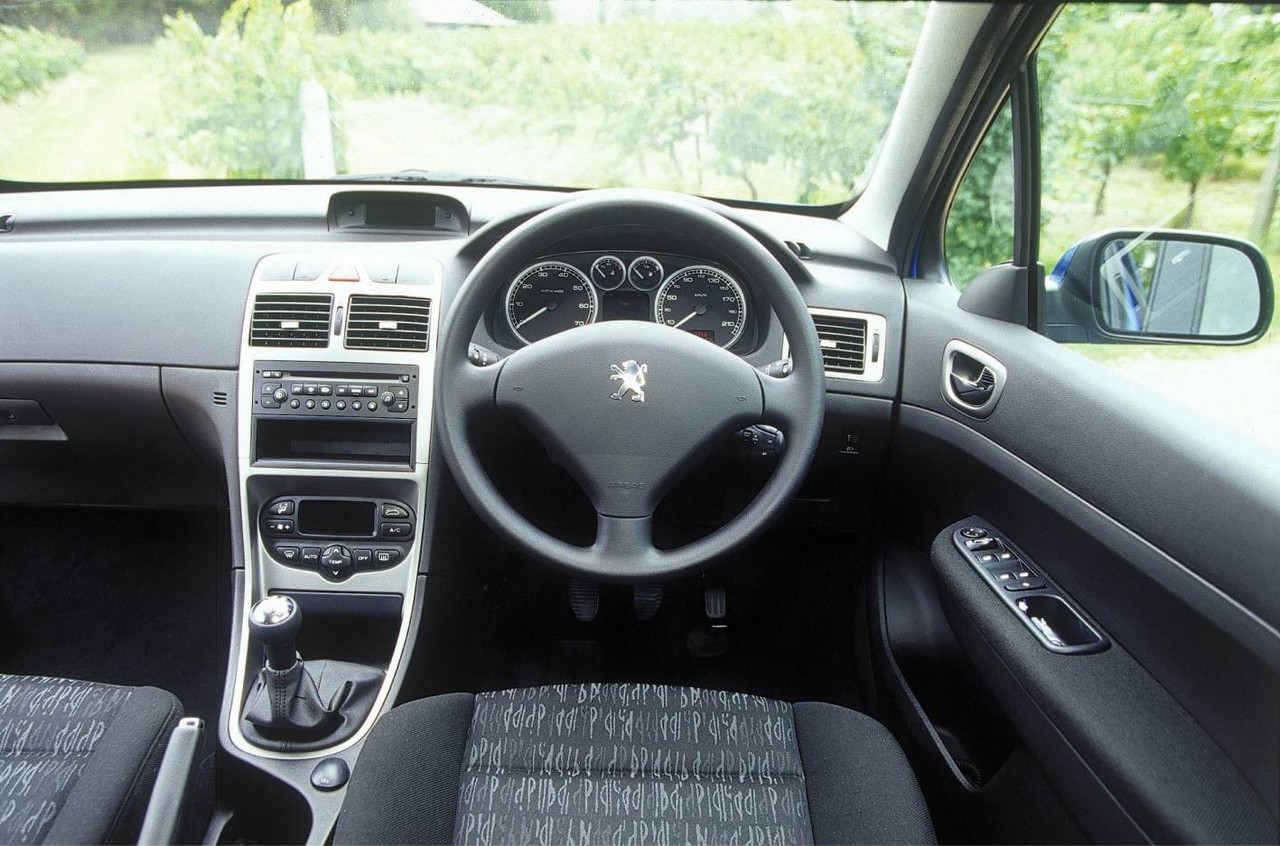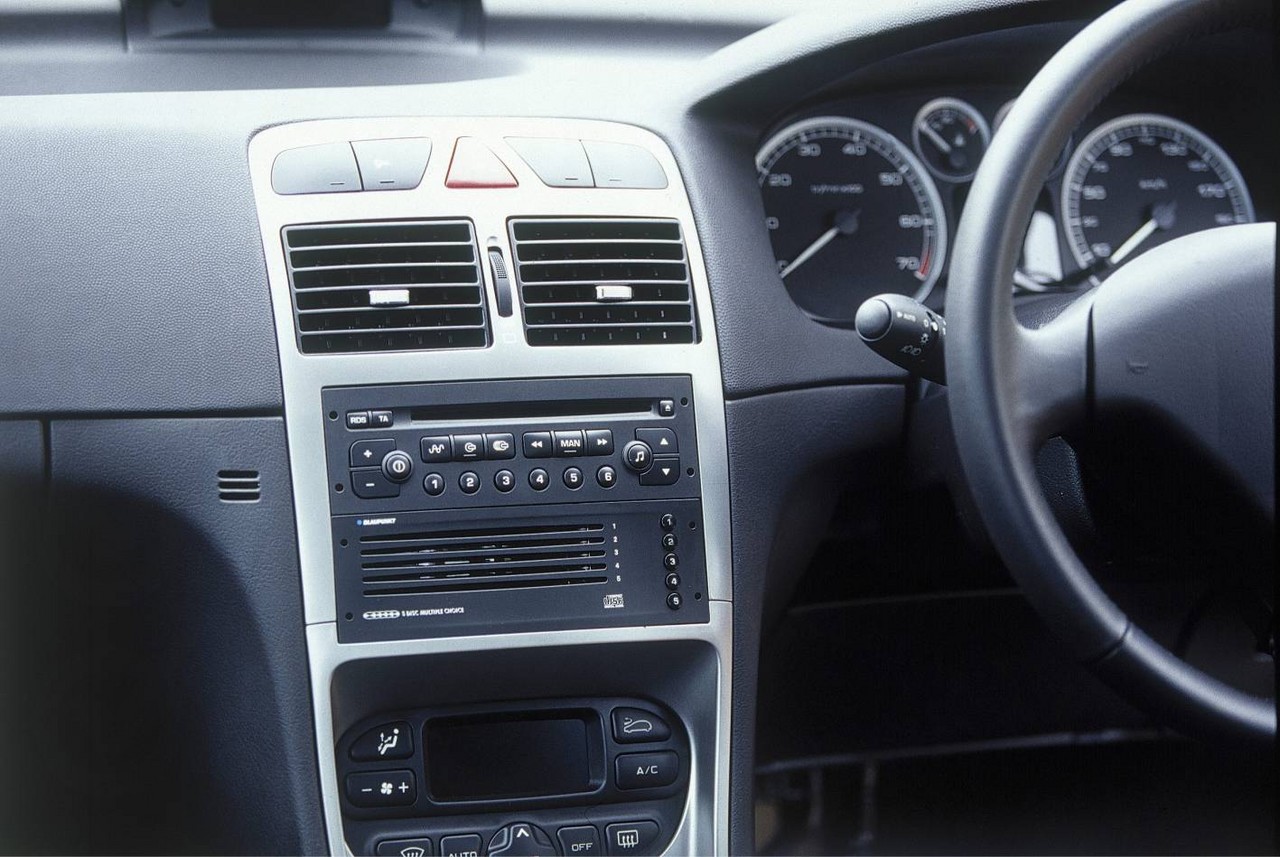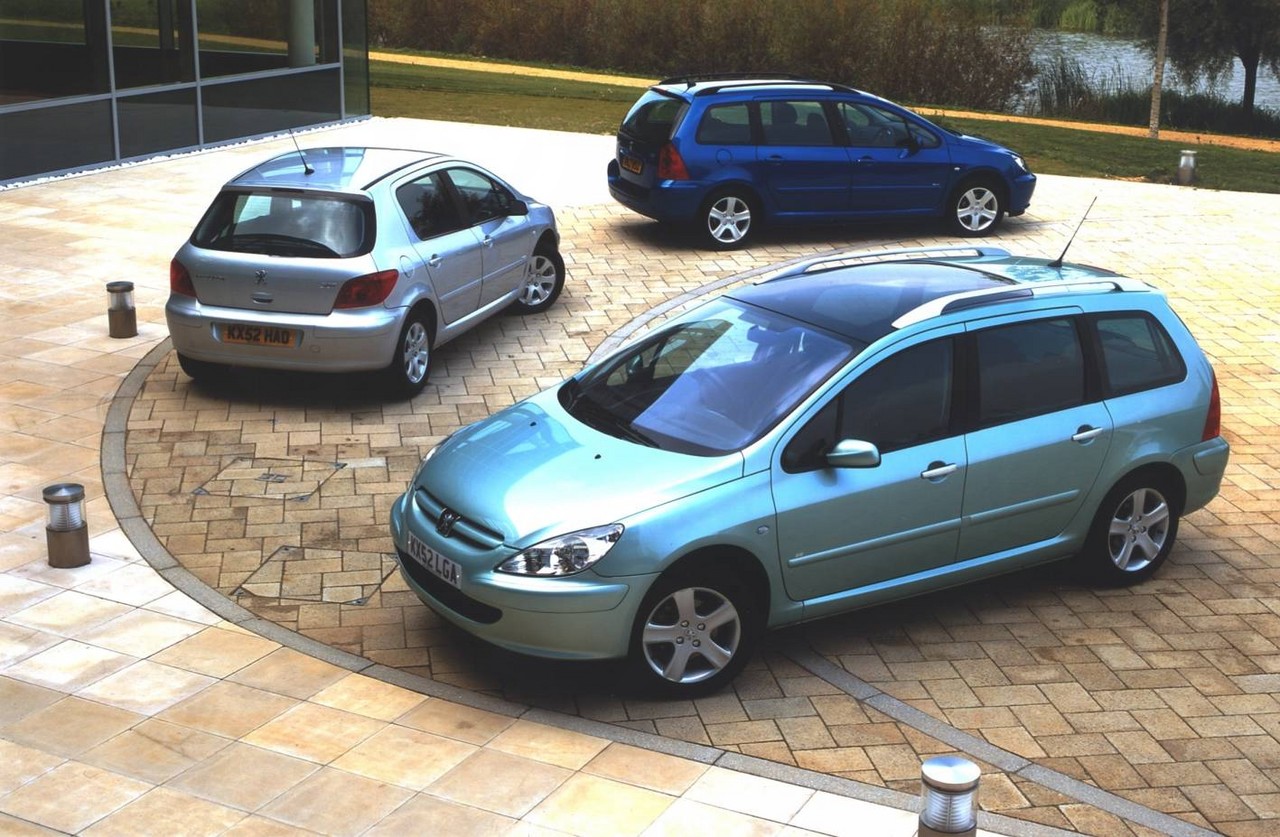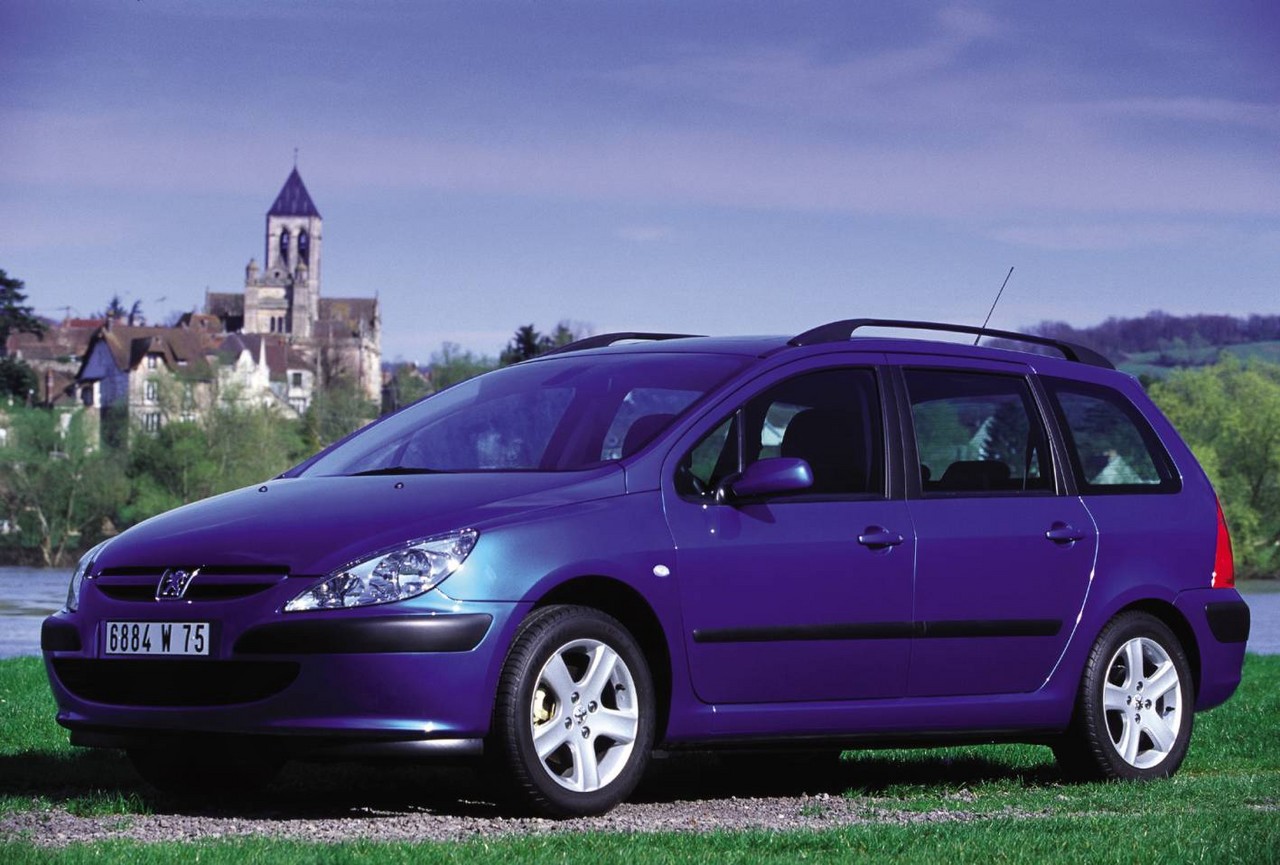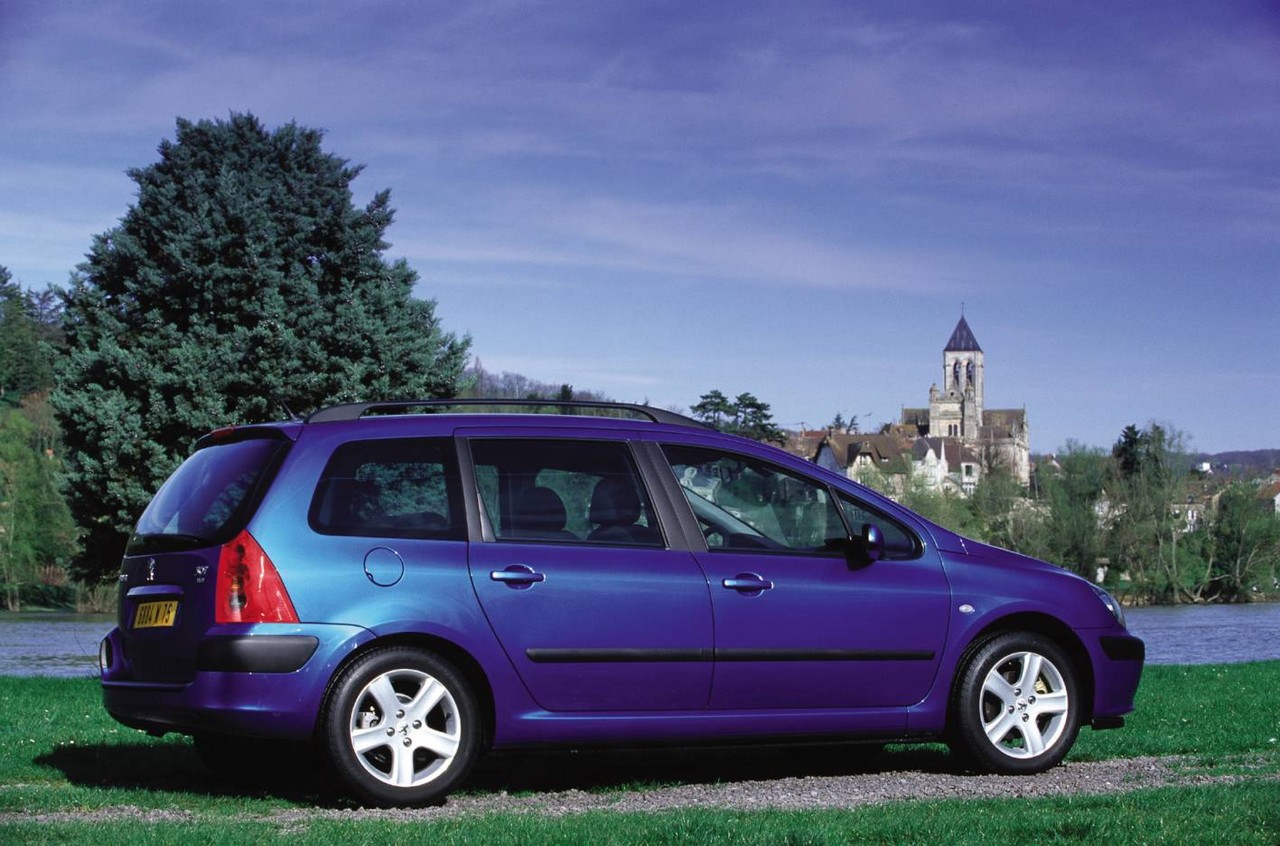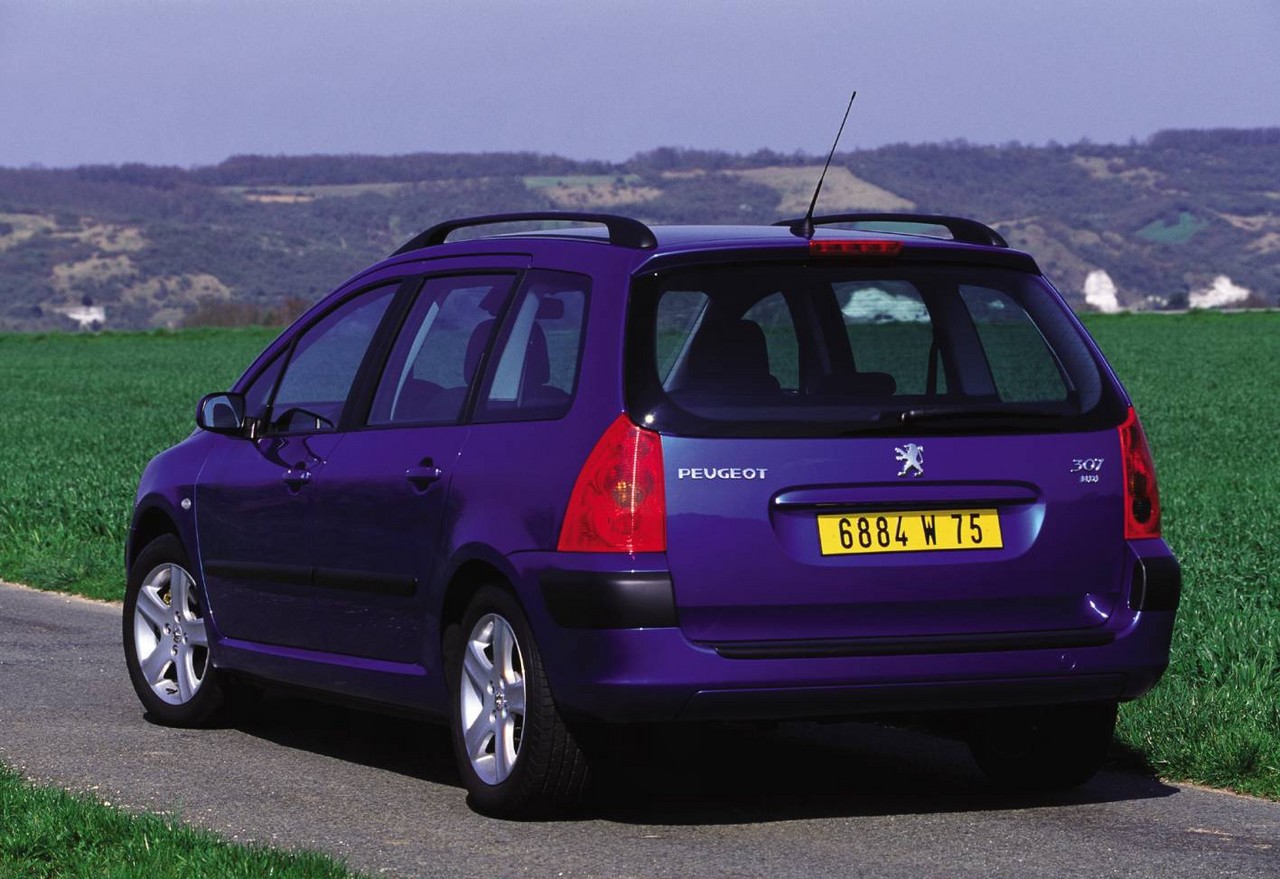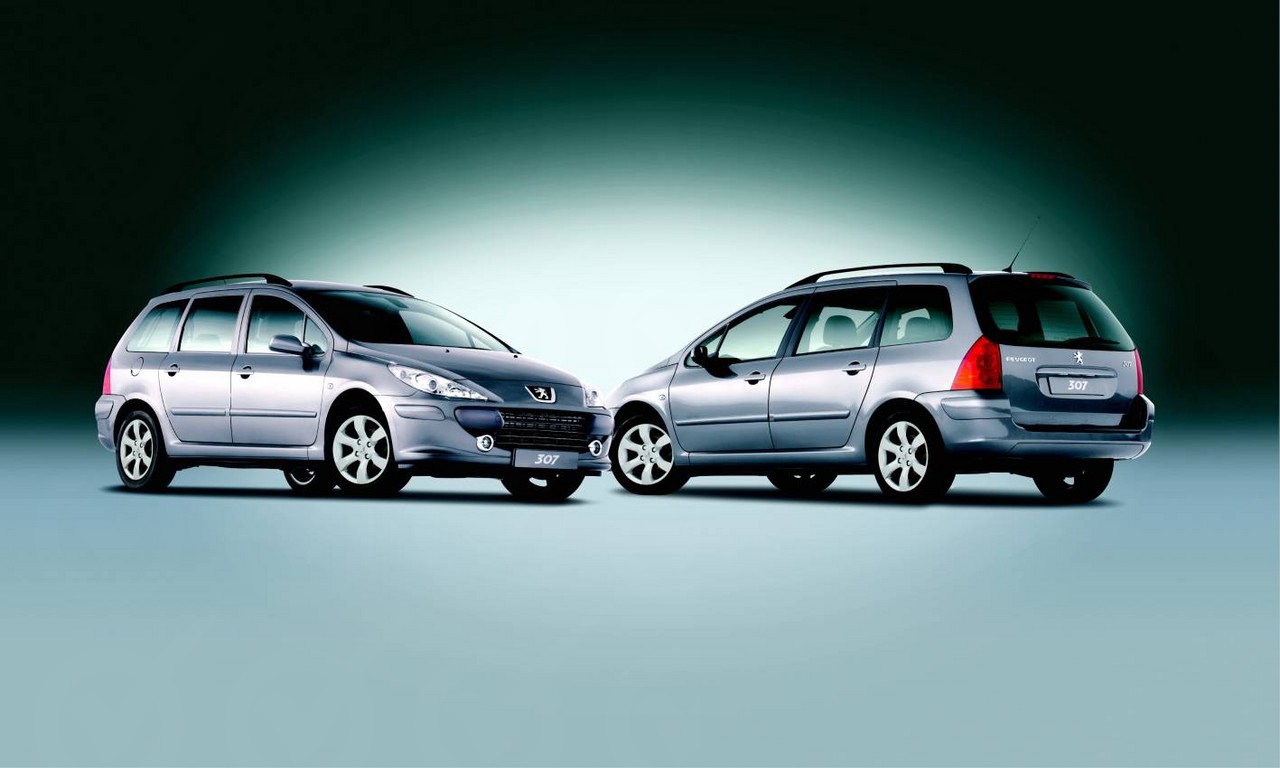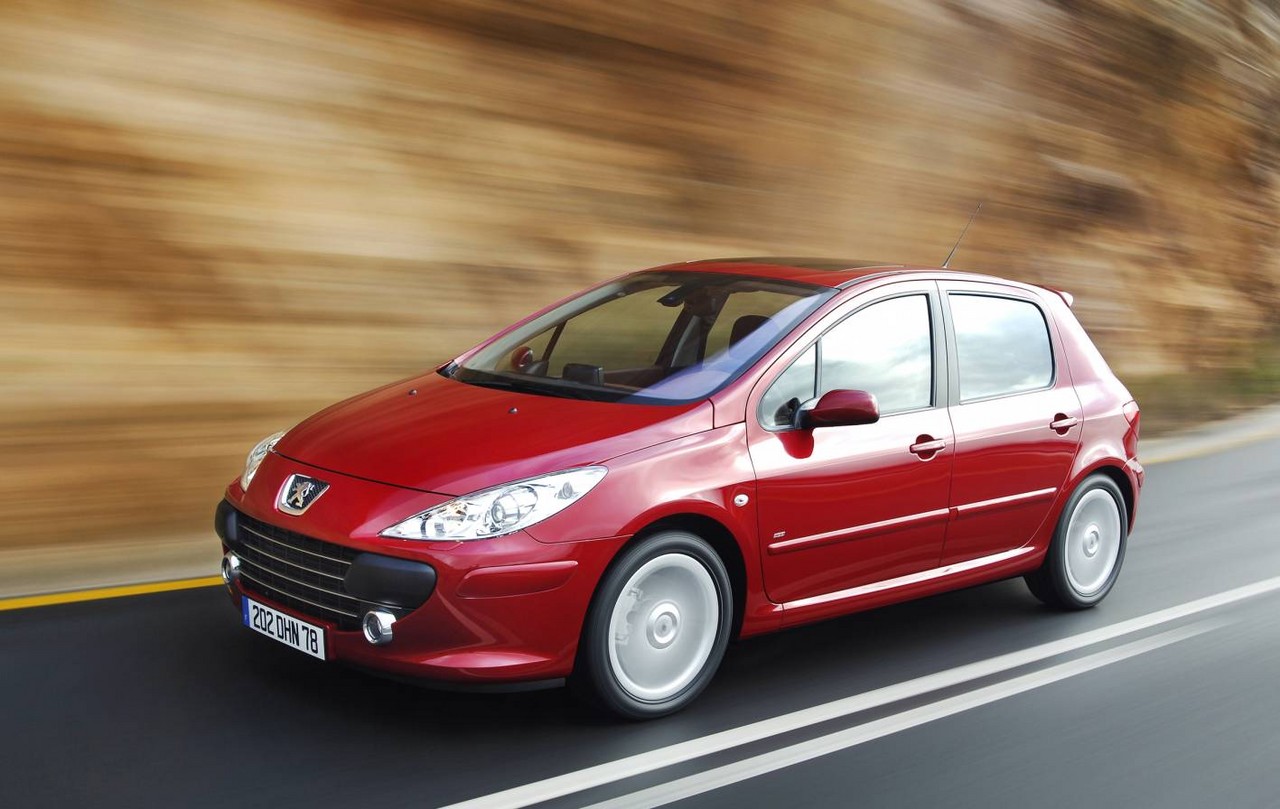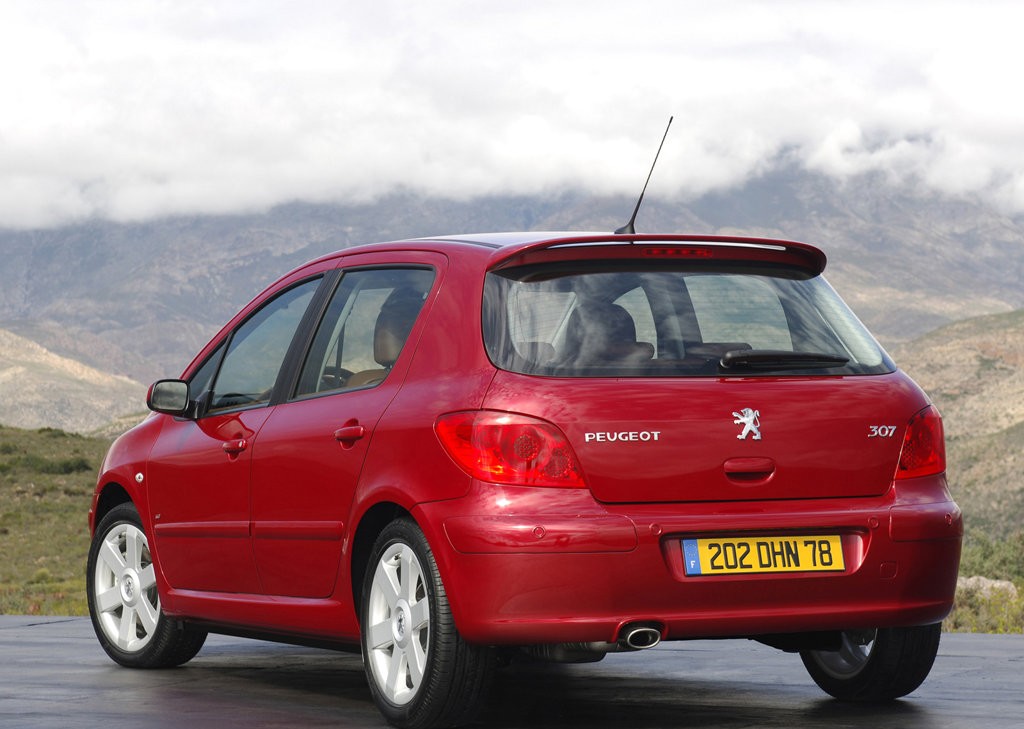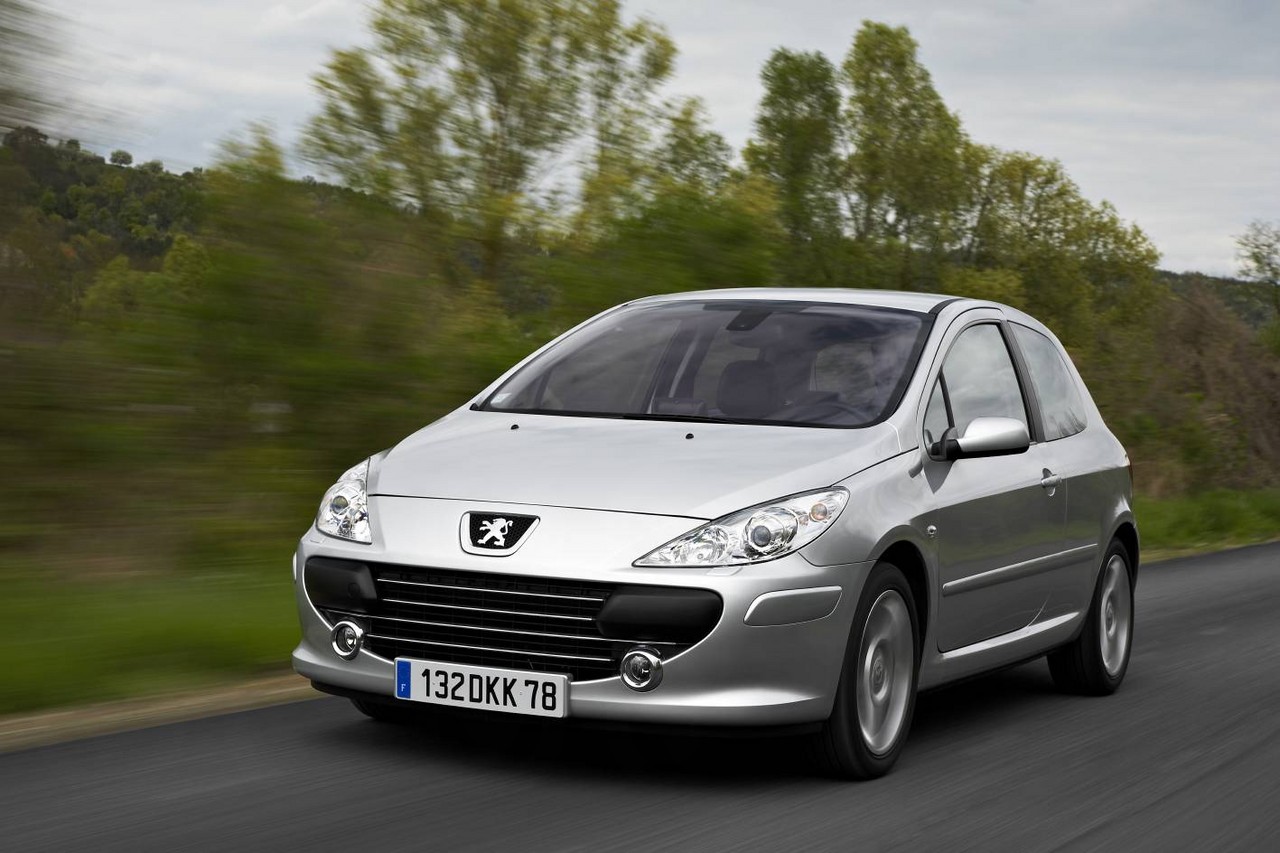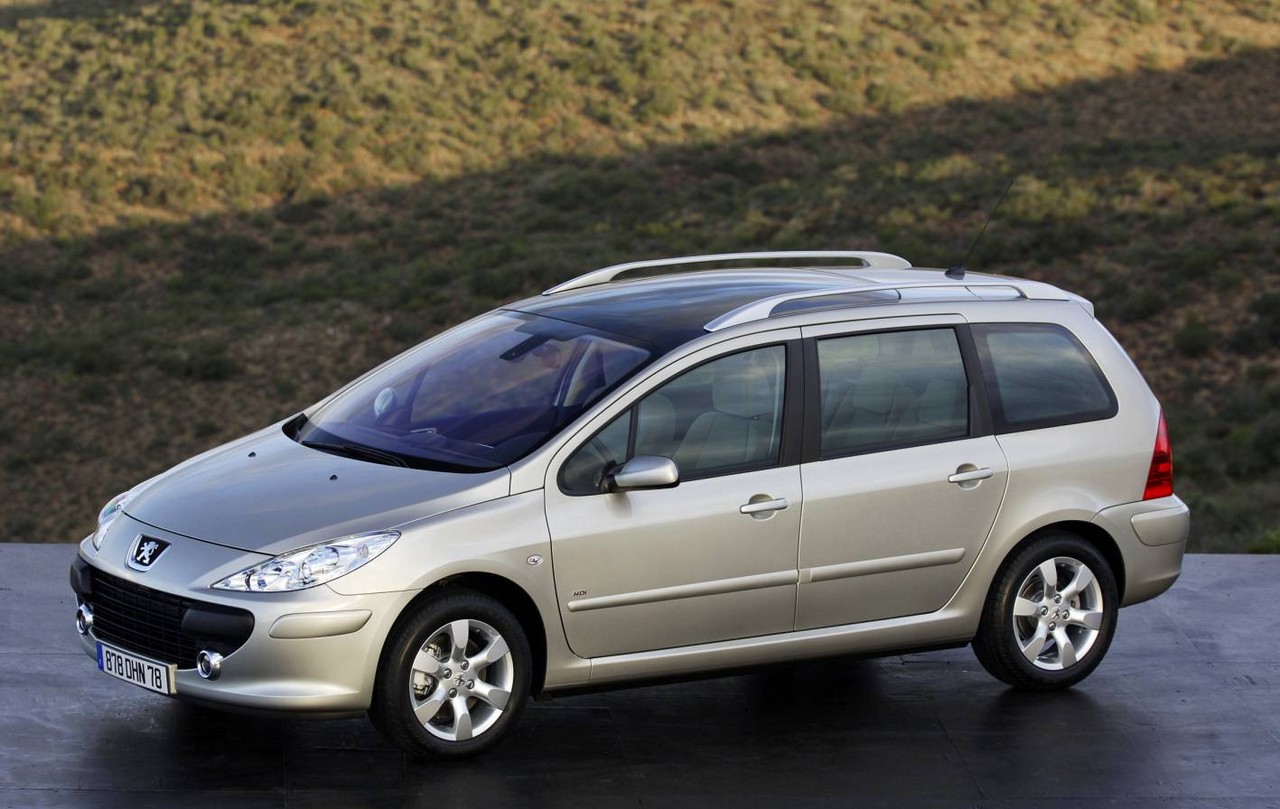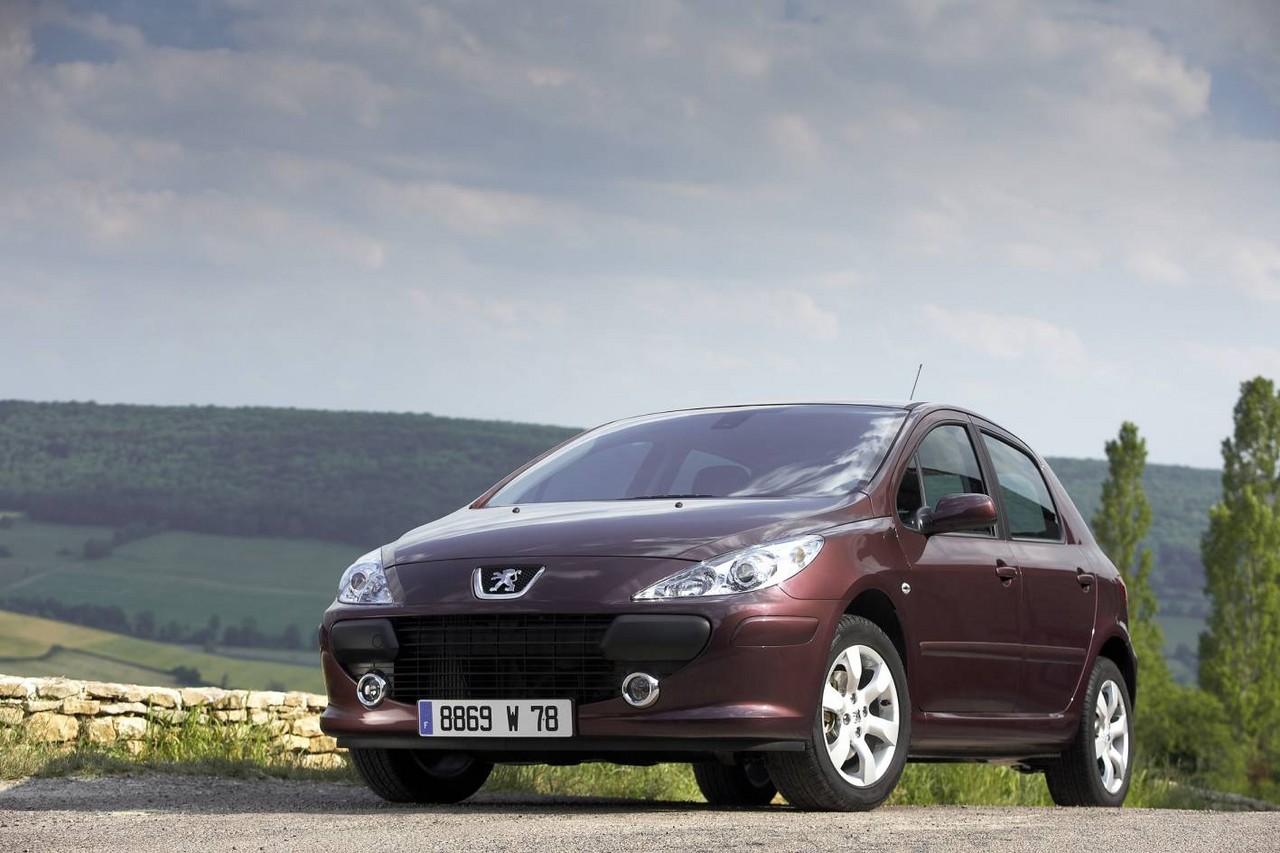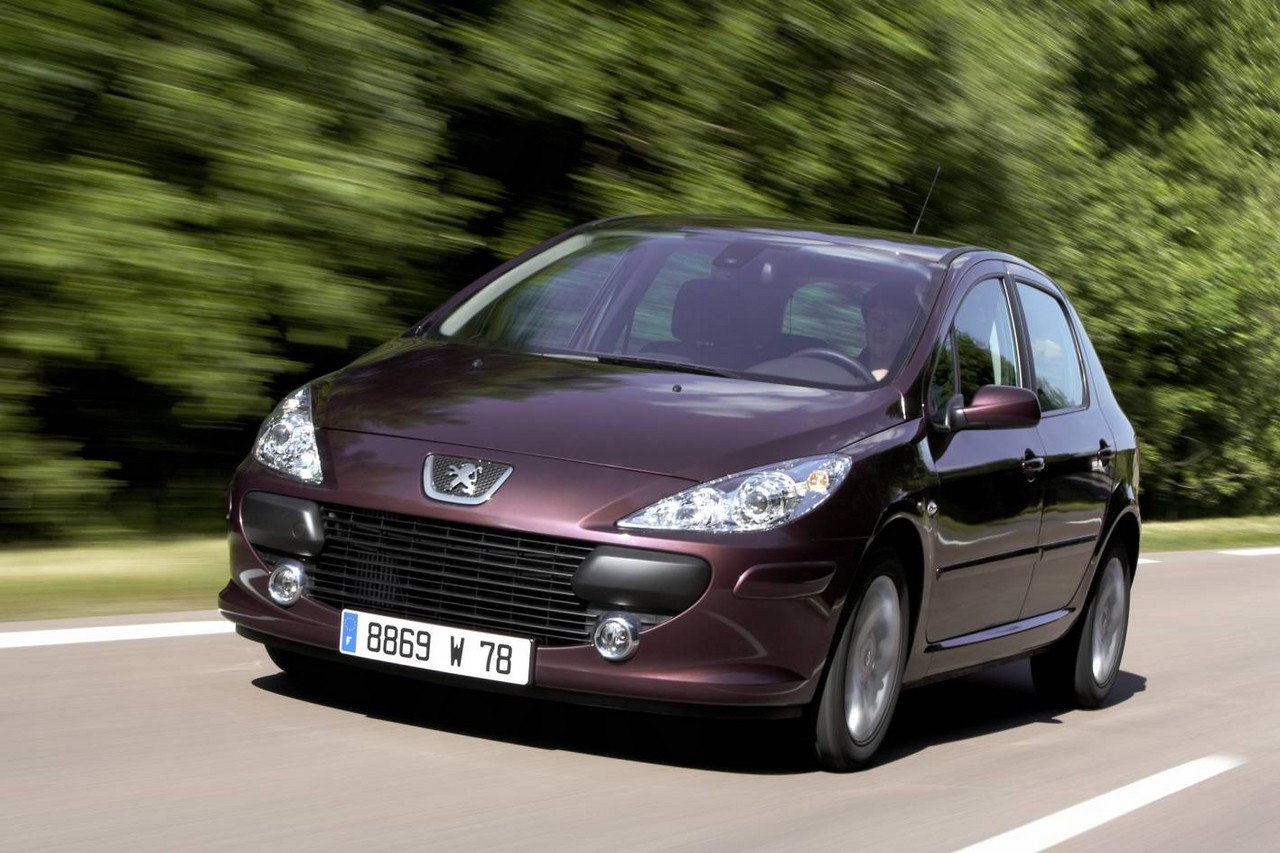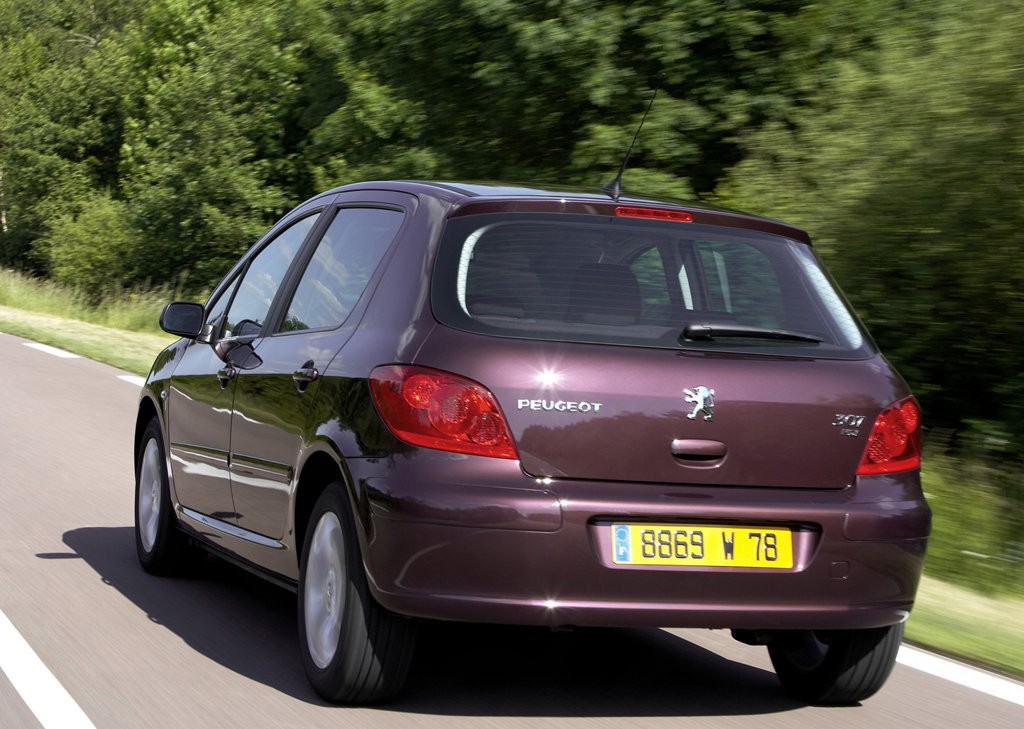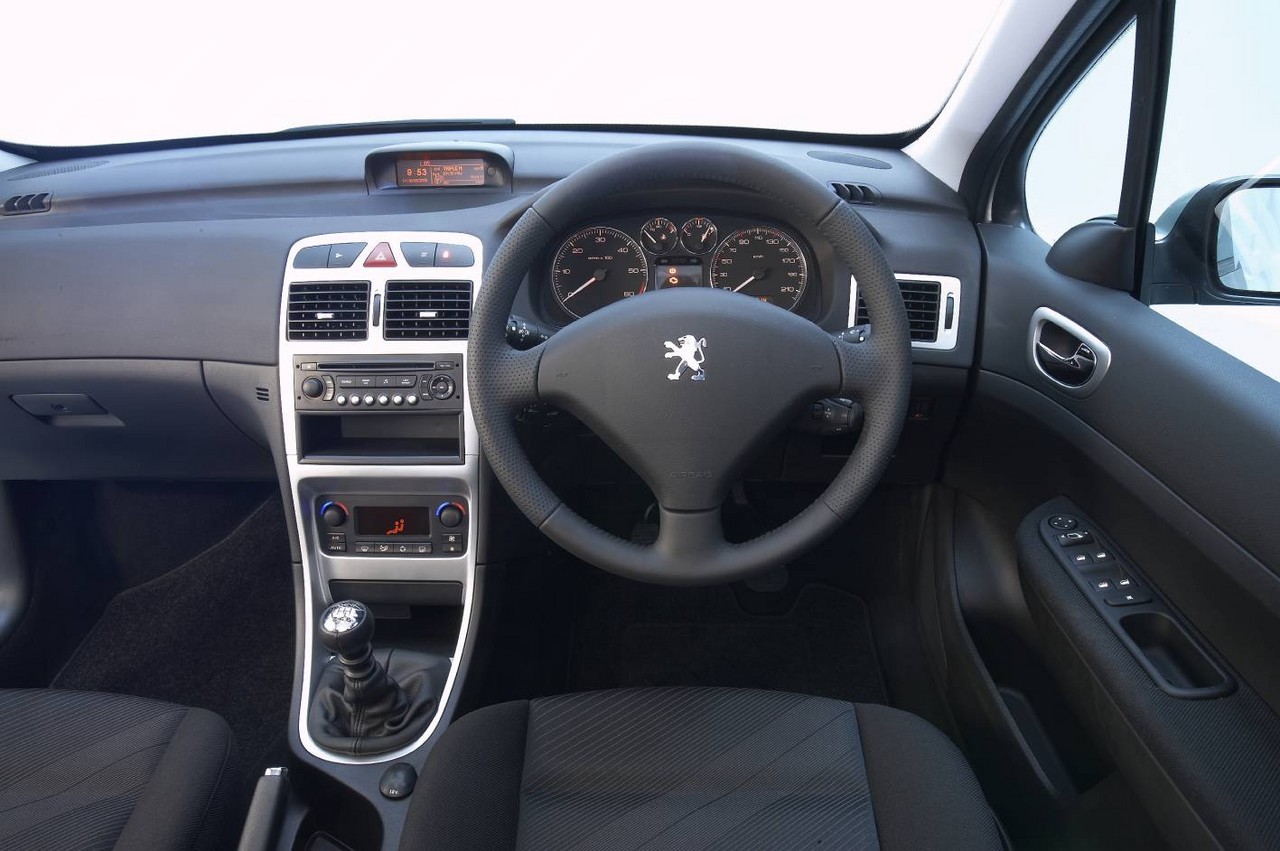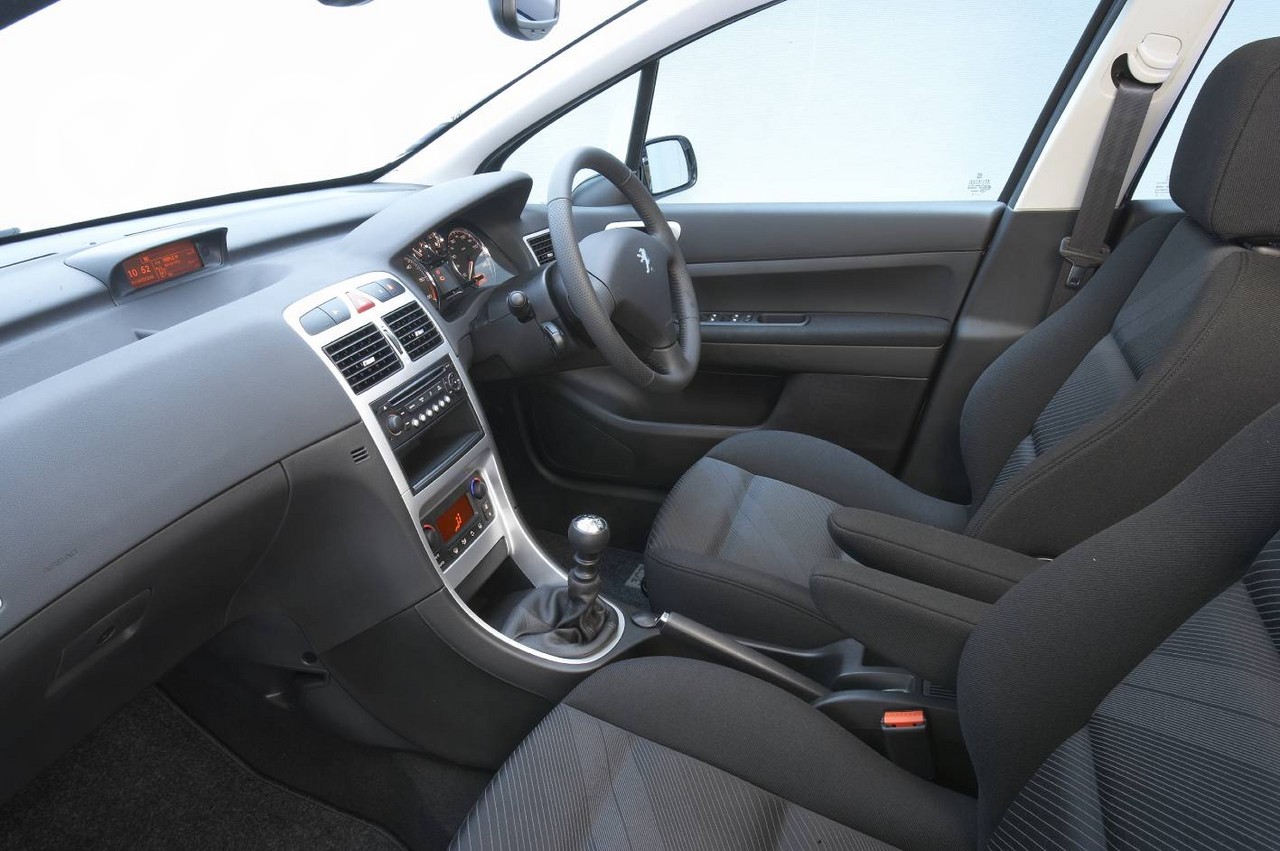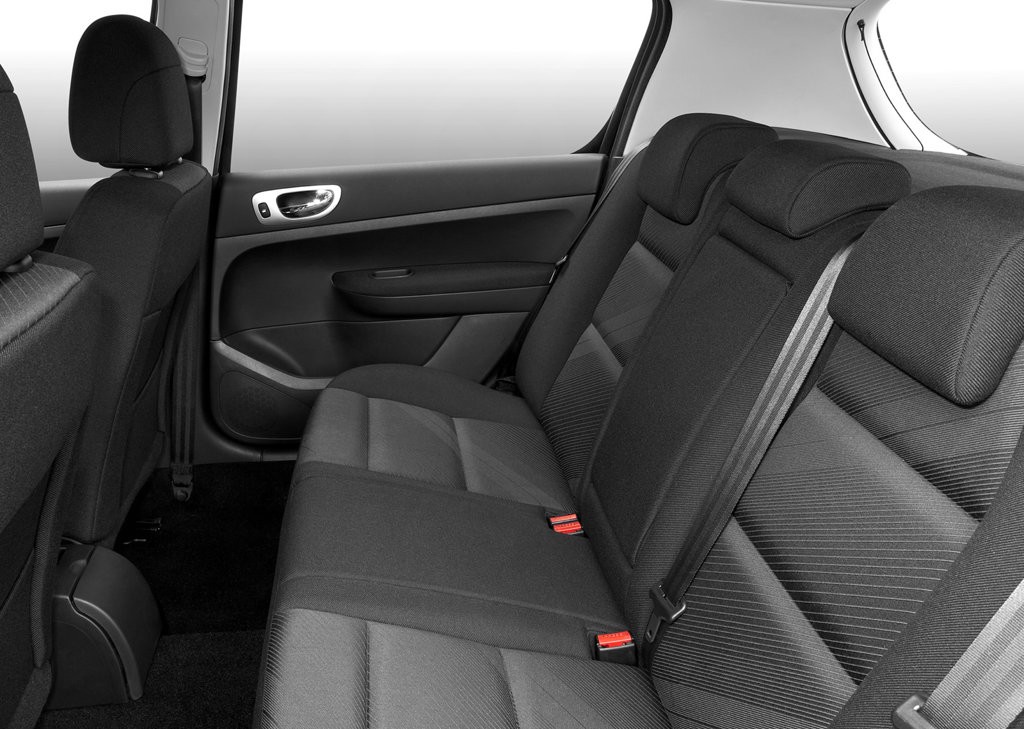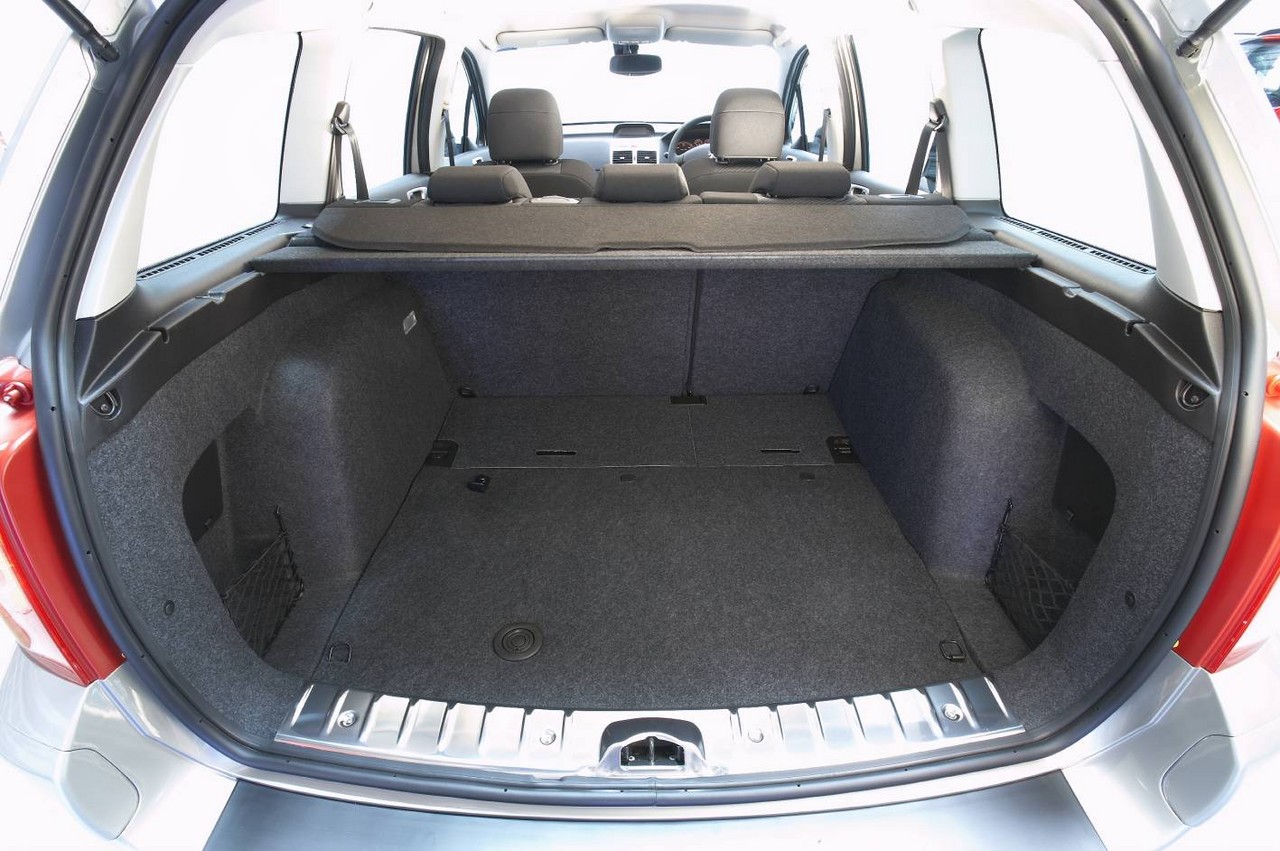
- Flexible 1.6-litre petrol engine
- Responsive 2.0-litre petrol engine
- Frugal 2.0-litre turbo-diesel engine
- Impressive dynamics
- Accurate, well-weighted steering provides good feedback
- Spacious interior
- For T5 307, suspension lacks compliance
- For manual models, offset clutch and brake pedals are close together
- Illogical speedometer interval markings (30, 50, 70, etc)
- Windscreen wipers lack coverage next to the driver’s A-pillar
Review: Peugeot T5 307 (2001-05)
Overview
Released in November 2001, the Peugeot T5 307 was initially offered as a small, five-door hatchback, though the range was subsequently expanded with three-door hatchbacks in March 2002 and Touring (wagon) models in October 2003. Manufactured in Sochaux, France, the front-wheel drive 307 was available with five different engines and in five variants (see table below).
Compared to their 306 predecessors, the 307 hatchbacks were 172 mm longer (at 4202 mm), 66 mm wider (1746 mm), 132 mm taller (1512 mm) and had 28 mm longer wheelbase (2608 mm). Relative to the 307 hatch, however, the 307 Touring was 217 mm longer (at 4419 mm), 11 mm wider (1757 mm), 21 mm taller (1533 mm) and had a 100 mm longer wheelbase (2708 mm).
The Peugeot 307 had MacPherson strut front suspension and a torsion beam rear axle (both with coil springs, hydraulic shock absorbers and anti-roll bars).
| Body | Engine | Variant | Year | Trans. | Peak power | Peak torque |
|---|---|---|---|---|---|---|
| 3-door hatch | 2.0-litre petrol I4 | XSi | 2002-05 | 4sp auto, 5sp man. |
100 kW at 6000 rpm | 190 Nm at 4100 rpm |
| 5-door hatch | 1.6-litre petrol I4 | XS | 2001-05 | 4sp auto, 5sp man. |
80 kW at 5800 rpm | 147 Nm at 4000 rpm |
| 2.0-litre petrol I4 | XSE | 2001-05 | 4sp auto, 5sp man. |
100 kW at 6000 rpm | 190 Nm at 4100 rpm | |
| XSR | 2004-05 | |||||
| 1.6-litre turbo-diesel I4 | XSR | 2005 | 5sp man. | 80 kW at 4000 rpm | 240 Nm at 1750 rpm | |
| 2.0-litre turbo-diesel I4 | HDi | 2001-03 | 5sp man. | 66 kW at 4000 rpm | 205 Nm at 1900 rpm | |
| XS | 2004-05 | |||||
| 5-door wagon | 2.0-litre petrol I4 | XSE | 2003-05 | 4sp auto, 5sp man. |
100 kW at 6000 rpm | 190 Nm at 4100 rpm |
| XSR | 2005 | |||||
| 1.6-litre turbo-diesel I4 | XSR | 2005 | 5sp man. | 80 kW at 4000 rpm | 240 Nm at 1750 rpm | |
| 2.0-litre turbo-diesel I4 | XS | 2003-05 | 5sp man. | 66 kW at 4000 rpm | 205 Nm at 1900 rpm | |
| XSR | 2005 | 6sp man. | 100 kW at 4000 rpm | 320 Nm at 2000 rpm |
Safety equipment
Standard safety equipment for the T5 307 included dual front airbags, front side airbags, full-length curtain airbags (i.e. for front and rear occupants), ABS, electronic brake force distribution, brake assist, active front seat head restraints and front and outer rear seatbelts with pretensioners and force limiters.
Euro NCAP crash testing
In Euro NCAP crash testing , a five-door 307 hatchback with a 1.6-litre petrol engine received a four star adult occupant protection rating with a score of 29.6. In the frontal offset impact, the driver’ s chest hit the steering wheel and the front passenger’ s head struck the fascia; structures behind the fascia also posed an injury risk for the driver. In the side and pole impact tests, however, maximum points were awarded.
Features
Standard features for the 307 XS included 15-inch steel wheels, a six speaker sound system with CD player, climate control air conditioning, cooled glovebox, 60/40 split and folding rear seat, rear fog lamps, remote central locking, power windows, power adjustable and heated mirrors, a heat reflective windscreen, height adjustable front seats, trip computer and an immobiliser. The 307 HDi was similarly equipped to the XS, but added cruise control.
The 307 XSR was further equipped with 16-inch alloy wheels, cruise control and body-coloured bumper strips and side mouldings. Beyond this, the range-topping 307 XSE featured a five-disc Blaupunkt CD player, front fog lamps, automatic headlights, rain-sensing wipers, rear 12 volt power outlet and leather-wrapped steering wheel, gear knob and gear lever.
2002 Peugeot 307 XSi
Released in March 2002, the three-door XSi was based on the XSE, but added 17-inch alloy wheels and leather bolstered sports seats with cloth inserts.
Review: Peugeot T6 307 (2005-07)
Overview
Released in October 2005, the Peugeot T6 307 introduced a revised line-up and updated styling. The three-door XSi hatchback was discontinued and effectively replaced by the five-door Sport, which also introduced a high-output 2.0-litre four-cylinder petrol engine.
Visually, the T6 307 could be identified by its gaping front grille, elliptical head lights, shorter aluminium bonnet, front fog lights with chrome surrounds, revised bumpers and tail-lights (with LEDs for the wagon models). Inside, the interior featured higher quality materials, a multifunction display (including an on-board computer), seatbelt fastening indicator with warning and an upgraded sound system.
| Body | Engine | Variant | Year | Trans. | Peak power | Peak torque |
|---|---|---|---|---|---|---|
| 5-door hatch | 1.6-litre petrol I4 | XS | 2005-07 | 4sp auto, 5sp man. |
80 kW at 5800 rpm | 147 Nm at 4000 rpm |
| 2.0-litre petrol I4 | XSE | 2005-07 | 4sp auto, 5sp man. |
103 kW at 6000 rpm | 200 Nm at 4000 rpm | |
| Sport | 5sp man. | 130 kW at 7000 rpm | 202 Nm at 4750 rpm | |||
| 1.6-litre turbo-diesel I4 | XS | 2005-07 | 5sp man. | 80 kW at 4000 rpm | 240 Nm at 1750 rpm | |
| 2.0-litre turbo-diesel I4 | XSE | 2005-07 | 6sp auto, 6sp man. |
100 kW at 4000 rpm | 320 Nm at 2000 rpm | |
| OXYGO | 2006 | 6sp auto | 100 kW at 4000 rpm | 320 Nm at 2000 rpm | ||
| 5-door wagon | 2.0-litre petrol I4 | XSE | 2005-07 | 4sp auto, 5sp man. |
103 kW at 6000 rpm | 200 Nm at 4000 rpm |
| 1.6-litre turbo-diesel I4 | XS | 2005-07 | 5sp man. | 80 kW at 4000 rpm | 240 Nm at 1750 rpm | |
| 2.0-litre turbo-diesel I4 | XSE | 2005-07 | 6sp auto, 6sp man. |
100 kW at 4000 rpm | 320 Nm at 2000 rpm | |
| OXYGO | 2006 | 6sp auto | 100 kW at 4000 rpm | 320 Nm at 2000 rpm |
Safety equipment
For the T6 307, standard safety equipment was enhanced with dual-volume, twin-generator front airbags, a new deployment system for the front side air bags and new active front seat head restraints which had a better profile for head protection.
Features
Standard features for the T6 307 were extended to include dual zone climate control air conditioning, cruise control with speed limiter and front fog lamps. Key features on the newly-introduced Sport included 17-inch alloy wheels, xenon headlights, integral leather interior (seats, fascia, door trims), tyre pressure monitors, white faced gauges and aluminium interior highlights.
Peugeot 307 OXYGO
Released in November 2006, the limited-run OXYGO variant was based on the 2.0-litre HDi XSE, but added 17-inch six-spoke ‘Aidel’ alloy wheels, rear parking sensors, a five-disc CD player, white-faced instrument dials and charcoal cloth trim.
Brochure
Related links
